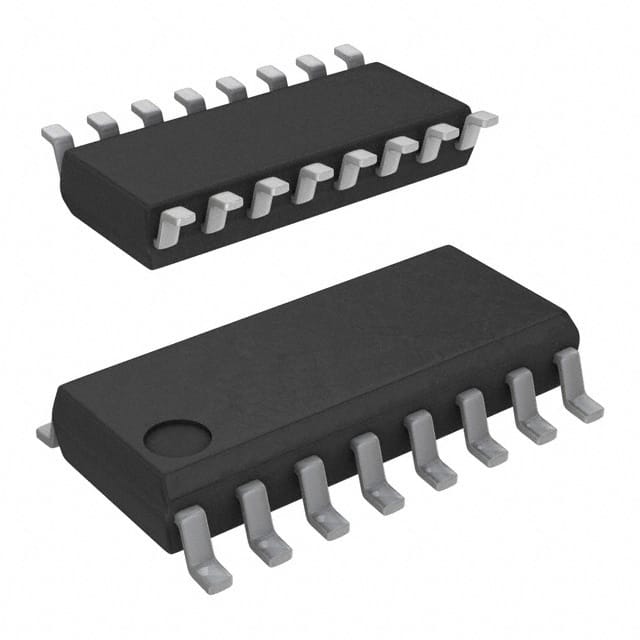Lihat spesifikasi untuk detail produk.

CD74HC157M96E4
Product Overview
- Category: Integrated Circuit
- Use: Multiplexer/Demultiplexer
- Characteristics: High-speed, CMOS logic, 2-input multiplexer/demultiplexer
- Package: SOIC-16
- Essence: Logic IC for data routing and selection
- Packaging/Quantity: Tape and Reel, 2500 units per reel
Specifications
- Supply Voltage Range: 2V to 6V
- Input Voltage Range: 0V to VCC
- Output Voltage Range: 0V to VCC
- Operating Temperature Range: -40°C to +85°C
- Propagation Delay Time: 13 ns (typical)
- Maximum Quiescent Current: 4µA at 5.5V
- Maximum Input Current: ±1µA at 5.5V
- Maximum Output Current: ±25mA at 5.5V
Detailed Pin Configuration
The CD74HC157M96E4 has a total of 16 pins arranged as follows:
__ __
A1 -| 1 16 |- VCC
B1 -| 2 15 |- Y1
A2 -| 3 14 |- Y2
B2 -| 4 13 |- Y3
G1 -| 5 12 |- Y4
G2 -| 6 11 |- Y5
Y0 -| 7 10 |- Y6
GND -| 8 9 |- Y7
¯¯ ¯¯
Functional Features
- The CD74HC157M96E4 is a 2-input multiplexer/demultiplexer that can select one of the two data inputs and route it to the output.
- It operates at high speed and is compatible with CMOS logic levels.
- The device has a wide supply voltage range, making it suitable for various applications.
- It features low power consumption and can operate in a wide temperature range.
Advantages and Disadvantages
Advantages: - High-speed operation allows for efficient data routing and selection. - Wide supply voltage range enables compatibility with different systems. - Low power consumption makes it energy-efficient. - Compact SOIC-16 package offers ease of integration into circuit designs.
Disadvantages: - Limited number of input/output channels compared to other multiplexer/demultiplexer ICs. - Propagation delay time may affect real-time applications requiring instantaneous data switching.
Working Principles
The CD74HC157M96E4 functions as a 2-input multiplexer/demultiplexer by utilizing CMOS logic. When the select inputs (A1 and A2) are set accordingly, the device routes the selected data input (B1 or B2) to the corresponding output (Y1 to Y7). The enable inputs (G1 and G2) control the operation of the multiplexer/demultiplexer. When both enable inputs are high, the outputs are in a high-impedance state.
Detailed Application Field Plans
The CD74HC157M96E4 finds applications in various fields, including:
- Data communication systems: Used for data routing and selection in multiplexing/demultiplexing applications.
- Industrial automation: Enables efficient control signal routing in automated systems.
- Consumer electronics: Integrated into audio/video equipment for channel selection and signal routing.
- Automotive electronics: Utilized in vehicle control systems for data routing and selection.
- Telecommunications: Facilitates data routing and selection in telecommunication networks.
Detailed and Complete Alternative Models
- CD74HC153M96E4: 2-input multiplexer/demultiplexer with additional features.
- CD74HC238M96E4: 3-to-8 line decoder/demultiplexer with similar characteristics.
- CD74HC4051M96E4: 8-channel analog multiplexer/demultiplexer for analog signal routing.
These alternative models offer similar functionality and can be considered based on specific application requirements.
Word count: 389 words
Sebutkan 10 pertanyaan dan jawaban umum terkait penerapan CD74HC157M96E4 dalam solusi teknis
Sure! Here are 10 common questions and answers related to the application of CD74HC157M96E4 in technical solutions:
Q: What is CD74HC157M96E4? A: CD74HC157M96E4 is a quad 2-input multiplexer IC (Integrated Circuit) that can be used for data selection and routing in digital circuits.
Q: What is the operating voltage range of CD74HC157M96E4? A: The operating voltage range of CD74HC157M96E4 is typically between 2V and 6V.
Q: What is the maximum input current of CD74HC157M96E4? A: The maximum input current of CD74HC157M96E4 is typically 1µA.
Q: How many inputs does CD74HC157M96E4 have? A: CD74HC157M96E4 has four inputs, labeled A, B, C, and D.
Q: What is the output configuration of CD74HC157M96E4? A: CD74HC157M96E4 has two outputs, Y and Y̅, which provide complementary outputs based on the selected input.
Q: Can CD74HC157M96E4 handle high-speed data signals? A: Yes, CD74HC157M96E4 is designed to handle high-speed data signals with minimal propagation delay.
Q: What is the typical propagation delay of CD74HC157M96E4? A: The typical propagation delay of CD74HC157M96E4 is around 9ns.
Q: Is CD74HC157M96E4 compatible with TTL (Transistor-Transistor Logic) inputs? A: Yes, CD74HC157M96E4 is compatible with TTL inputs and can be used in mixed logic systems.
Q: Can CD74HC157M96E4 be used in battery-powered applications? A: Yes, CD74HC157M96E4 has a low power consumption and can be used in battery-powered applications.
Q: What is the package type of CD74HC157M96E4? A: CD74HC157M96E4 is available in a 16-pin SOIC (Small Outline Integrated Circuit) package.
Please note that the answers provided here are general and may vary depending on the specific datasheet and manufacturer's specifications for CD74HC157M96E4.

